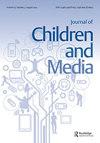COVID-19 and children’s screen time in Ceará, Brazil: a repeated cross-sectional survey
IF 2.1
3区 心理学
Q2 COMMUNICATION
引用次数: 1
Abstract
ABSTRACT In the present study, we assessed changes in screen time exposure among 3–6-year-old children in Ceará, Brazil, in 2017 and in 2020 during the pandemic. We analyzed data from a state-wide repeated cross-sectional survey. The COVID impact research was conducted by phone interviews. American Academy of Pediatrics (AAP) and World Health Organization (WHO) guidelines were used to define elevated screen exposure. During the COVID-19 pandemic, the proportion of children with screen exposure above recommended levels was 96.8% among 3–4-year-old and 84.2% among 5–6-year-old children. There was a significant increase in proportion of 3–4-year-old children with elevated screen time (risk difference 15.8%; 95% confidence interval (CI): 12.3–19.2; p-value < 0.001). Children participating in remote learning activities had significantly lower television time with a mean difference of −0.8 hours daily (95% CI −0.3 – −1.3; p-value: 0.003) as compared to children not participating in remote learning. The necessary COVID-19 response measures appear to increase screen time among 3–6-year-old children in Ceará, Brazil. Interventions to reduce excess screen time, potentially participation in remote early learning activities should be developed and evaluated in Brazil. IMPACT SUMMARY Prior State of Knowledge: The necessary COVID-19 response measures appear to increase sedentary time in children in developed countries. Novel contributions: COVID-19 response measures (social distancing and school closures) appear to increase screen time among 3–6-year-old children in Ceará, Brazil. In addition, children participating in remote learning activities had significantly lower television time than children not participating in remote learning. Practical implications: Public health officials should engage in helping support parents by creating safe areas for children to increase physical activity and reduce screen time, monitoring/setting limits on screen time that does not promote learning, and counsel and promote parents to be creative to engage children at home in active play during the COVID-19 pandemic. ABBREVIATIONS: Coronavirus Disease-19 (COVID-19)巴西塞埃尔的COVID-19与儿童屏幕时间:一项重复横断面调查
摘要在本研究中,我们评估了2017年和2020年疫情期间巴西塞阿拉3-6岁儿童屏幕时间暴露的变化。我们分析了全州重复横断面调查的数据。新冠肺炎影响研究是通过电话采访进行的。美国儿科学会(AAP)和世界卫生组织(世界卫生组织)的指南被用来定义高屏幕暴露。在新冠肺炎大流行期间,3-4岁儿童的屏幕暴露量高于推荐水平的比例为96.8%,5-6岁儿童为84.2%。筛查时间延长的3-4岁儿童比例显著增加(风险差异15.8%;95%置信区间(CI):12.3-19.2;p值<0.001)。与未参与远程学习的儿童相比,参与远程学习活动的儿童的电视时间显著减少,平均每天差异为-0.8小时(95%CI−0.3–−1.3;p值:0.003)。必要的新冠肺炎应对措施似乎增加了巴西塞阿拉3-6岁儿童的筛查时间。巴西应制定和评估减少过度屏幕时间、可能参与远程早期学习活动的干预措施。影响总结先前的知识状况:必要的新冠肺炎应对措施似乎增加了发达国家儿童的久坐时间。新贡献:新冠肺炎应对措施(保持社交距离和关闭学校)似乎增加了巴西塞阿拉3-6岁儿童的屏幕时间。此外,参与远程学习活动的儿童的电视时间明显低于未参与远程学习的儿童。实际影响:公共卫生官员应通过为儿童创建安全区域来帮助支持父母,以增加身体活动并减少屏幕时间,监测/设置不利于学习的屏幕时间限制,并建议和促进父母在新冠肺炎大流行期间发挥创造性,让儿童在家积极玩耍。缩写:冠状病毒病-19(新冠肺炎)
本文章由计算机程序翻译,如有差异,请以英文原文为准。
求助全文
约1分钟内获得全文
求助全文

 求助内容:
求助内容: 应助结果提醒方式:
应助结果提醒方式:


